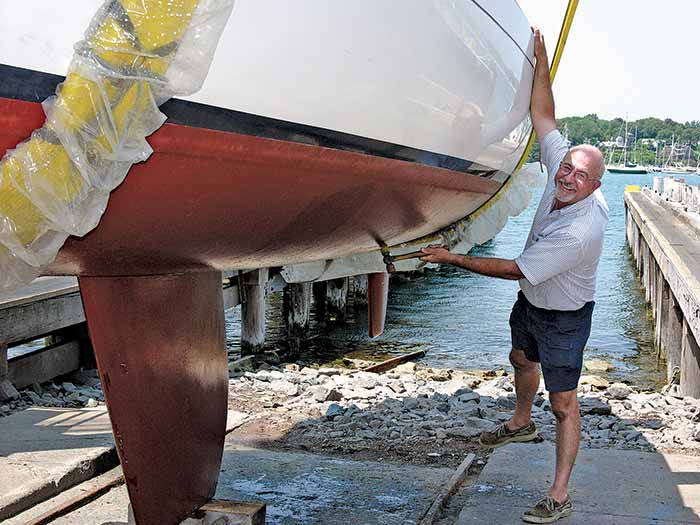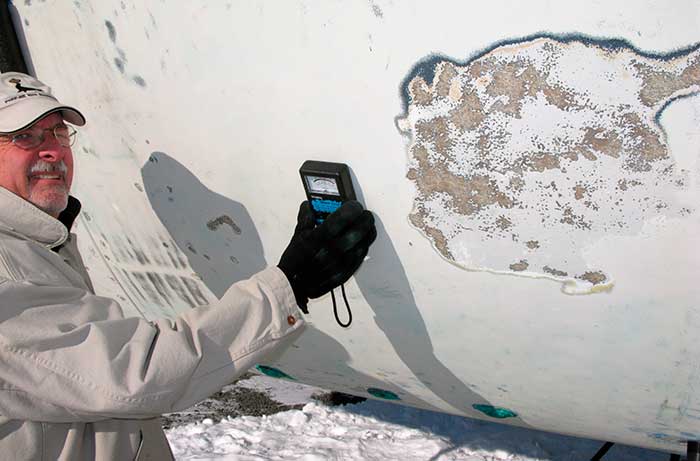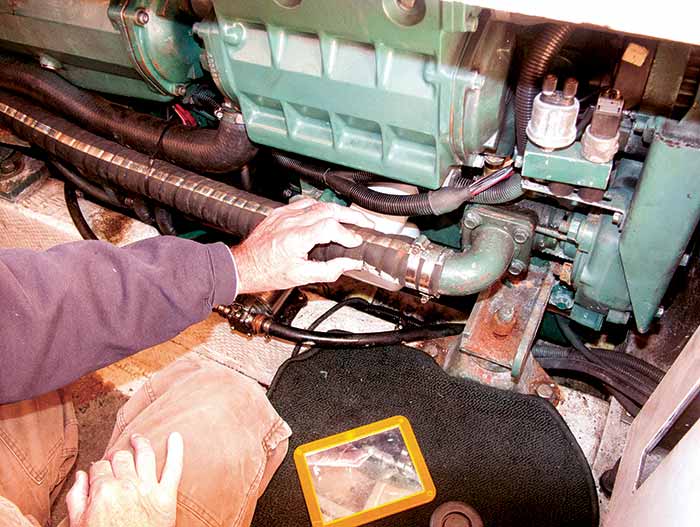Advertisement
There's no substitute for a proper marine survey, but there are some basic DIY inspection techniques. Here are some expert tips to view a boat with a critical eye.

Photo: Mark Corke
As both a magazine editor and an accredited marine surveyor, I've been aboard hundreds of boats in my career. In the latter role, while many of the boats I inspect have a few minor details to address, other times the boat is severely lacking in numerous areas, and there are inspections that reveal the boat is a potential death trap.
Buying a boat can be fraught with issues. Not only do you have to decide on the type and size of boat you want, you also have to set a budget, then visit prospects that can be hundreds of miles apart. Once you've found "the one," you make an offer, get the boat surveyed, maybe apply for financing, and get insurance, all before you take delivery.
Depending on the type of boat, you may save yourself grief, time, and money by looking at the vessel with a critical eye before calling in a surveyor. The first step? Take off those rose-colored glasses and take a hard look at the boat, which can help you spot potential problems.
According to Norm LeBlanc, a SAMS-accredited surveyor with more than 45 years in the marine industry, "Many buyers haven't done their homework before leaping into the buying process. They have no idea what sort of boat they want and will often spend all their money on the boat and have nothing left over for repairs, maintenance, insurance, and docking." LeBlanc advises taking along a knowledgeable friend because he or she may see things that you miss, and can offer a dispassionate take on the boat you're considering.
While surveyors may have an array of specialist tools not available to the casual buyer, there are things that you can do that won't cost you anything.
First Impressions
First impressions count for a lot. Does the boat look well-cared-for? Are both the interior and exterior neat and tidy?
You can't tell from photos what the boat smells like. If you open the hatch or door and are greeted by a damp and moldy smell, things often go downhill from there. Many boats have a "head" smell. While the sanitation system may not actually be leaking, it's usually an indication that the hoses are overdue for replacement or a lack of necessary cleaning by the owner. Rub a clean cloth along the sanitation hoses, then sniff it. If it has an odor, the hoses require replacement.
Advertisement
Wiring
Surveyors probably see more issues with boat wiring than anything else. Look at all visible wiring, such as in engine rooms where you'll often find the boat's batteries. Is the wiring neat and tidy? Give a little tug on each of the cables. Everything should be well attached, especially the thick main battery cables. Try to move the wires where they're bolted to the battery posts; these should be tight.
If you can, open the main breaker panel, typically at the chart table on sailboats or just inside the companionway on larger powerboats. If you need tools to open the panel, leave it to the professionals, but the panel is often closed with a simple latch. Be extremely careful around electrical panels, especially if they combine 120 volts AC voltage with 12 volts DC. "Look but don't touch" is a good rule of thumb. If you see a rat's nest of wires — a sure indication of haphazard "upgrades" — that's an indication that some rewiring may be required.
Surveyors are always on the lookout for wire nuts joining two or more pieces of wire. This happens with regular frequency and is sometimes done by unknowing owners who think that because they are commonplace in a house, there is no reason why they can't be used on a boat. Wire nuts have no place on a boat. If you see them, expect to have to get some localized rewiring done, at the very minimum.
Check The Hull Number
One of the first things a surveyor does is check the hull identification number, or HIN — a unique set of letters and numbers stamped into the transom's top starboard section. To the uninitiated, these numbers may appear purely random, but they contain essential information. Checking this number confirms that the boat you're considering is the one that's advertised. Sometimes, the boat may be advertised as being manufactured in one year when it is, in fact, older. This often happens if a boat has lingered in a showroom for a year or two. The HIN's last three digits are the most important: They tell you when the boat was built and which model year it is. (See "Decoding a HIN" below to learn how to "read" the number.)
Decoding a HIN
A typical hull identification number consists of 12 letters and numbers, as in ABC12345D404.
Here's what the letters and numbers mean:
- ABC: This is the Coast Guard-assigned manufacturer identification code (MIC). Go to the U.S. Coast Guard Manufacturers Identification page online to access the MIC database.
- 12345: This is the serial number assigned to the hull by the manufacturer and may be a combination of letters and numbers. The letters "I," "O," and "Q" are excluded because they could be mistaken for numbers.
- D: This is the month of certification, indicating the month in which construction began. "A" represents January, and "L" represents December. In our example, "D" means April.
- 4: This is the year of certification. The number is the last digit of the year in which the boat was built. "4" in this case designates 2004.
- 04: This indicates the boat's model year.
The Eyes Have It
If the boat is out of the water, walk around and look at it from every angle. Surveyors do this, looking for wavy topsides, gentle indentations, and other ripples. These are easier to spot if the boat is shiny, but even the sun shining on the topsides will often reveal problems. Stand directly in line with the front of the bow and rudder post. Sight along the hull. Does the boat look symmetrical? Things like a bent rudder post can often be spotted at this time. If the boat has an outboard, look carefully to see that it has been attached to the boat properly — more than once I've seen outboards that were not hung perpendicular.
On larger sailboats, carefully eye along the keel on both sides. The rudder should be perfectly aligned with the keel. If it's canted off to one side slightly, this could indicate an improper repair, a severe grounding, or a manufacturing defect.
While walking around the boat, check the gelcoat exterior. Is the gelcoat clean, shiny, well waxed? Are there stress cracks present where the boat has hit the dock or some other hard surface? These could be merely cosmetic, but they may indicate damage to the boat's structure, both to the boat's outer skin or interior bulkheads, tabbing, and other parts. Make a note of such areas, and when you are on the inside see if you can see any consequential damage.
Surveyors do use some special tools but also use readily available equipment like flashlights and mirrors. Take these with you when you look at any boat you're thinking of buying. These will allow you to see around corners so you'll be able to check areas of the boat you might otherwise miss.



A complete professional survey will encompass such things as engines, hull structure, rigging, and all other component parts, but there are a lot of basic checks that you can carry out yourself before calling in the pros.
Cored decks are common on modern boats, and often the core is made from balsa wood sandwiched between an inner and outer skin of fiberglass. Balsa is an almost perfect material in many ways: It's lightweight, cheap, and offers some measure of acoustic and thermal insulation. But if moisture finds its way into the balsa, it often leads to core rot or delamination, which can be expensive to fix. It's often impossible to spot problems from the outside. While surveyors will use moisture meters and infrared cameras to pinpoint issues, you might find areas of delamination simply by walking around the deck. In the latter stages of moisture ingress, the balsa will start to break down and offer little support between the inner and outer skins. Walk all over the deck in bare feet if you can. If an area feels spongy or springy underfoot, this is a good indication of problems.
How's The Power Plant?
Nearly all boats will have some form of motor, and although you may not have the necessary tools to carry out a thorough technical investigation, you can glean a lot from just looking at it. Lift the hood or remove the cover from the outboard and take a good hard look at the engine. Is it clean and tidy or a rusty mess? Are there oil leaks or other visible issues? If you can, try to get the broker or seller to start the engine for you from cold. Are there clouds of blue smoke? If so, that's an indication of oil being burned.
Pull the dipstick. Does the oil look clean? Oil in a diesel engine will turn black very soon after it's changed, so this is not necessarily an indication of issues. Sniff the oil to see if it smells burned. It could be a sign that the engine has badly overheated. Rub some oil between your fingers. A gritty texture may indicate that internal components are breaking down, leaving deposits in the oil. A milky color may indicate that water is finding its way into the crankcase, which could be from a leaking head gasket.
While you're there, locate the oil filter and see if there is any writing on it. Many mechanics will write the date that the oil and filter were changed on the filter body. Any date should be within the last 12 months at least. Anything outside of that may indicate that the engine has not been regularly serviced.
If the boat has an inboard engine, check the area where the propeller shaft exits the boat, often called the packing gland or stuffing box. If the boat is in the water and the boat is not underway, this area should not be leaking. If water is leaking into the boat while at rest or there is evidence water is being thrown around the engine space, this is often a good indicator that service to the stuffing box is required. Outside the boat, grasp the prop shaft and try to wiggle it from side to side and up and down. If you can, the cutless bearing is due for replacement.
Advertisement
Just For Sailboats
If you're evaluating a sailboat, check the chainplates. These are the vital parts that attach the shrouds and stays to a sailboat's structure, and are often overlooked. Chainplates can be of several types and may attach to the boat in different ways. Rust stains or wet areas below chainplates indicate that water is leaking through the deck, down the chainplate, and into the area below. Surveyors are often concerned that the stainless steel chainplates are suffering from corrosion inside the deck where damage cannot be seen.
Lift floorboards and check any keel bolts. You will often only be able to see the nuts and the last bit of thread, but severe corrosion could indicate that the bolts will need to be replaced — an expensive and time-consuming job.
Check The Internet
If you're considering a particular brand and model of boat, do an internet search. There are tons of boat forums and owner groups, so check out what people are saying online. Some makes of boats have known problems, so you'll get a good idea of specific items to check for when you get to the boat.
Look At The Paperwork
If you can, ask to see receipts for service and maintenance work. Even if the owner does some or all of his own servicing and repairs, he should have records from when things like the last service were undertaken and which parts were replaced.
What Comes With The Boat?
When buying a used boat, find out which accessories are included. Things like life rafts, EPIRBS, and dinghies, although not part of the boat, are often indicators of how the main vessel has been maintained. Surveyors will always check expiration dates on accessories that have service tags, and this is something that you can do as a buyer — no fancy tools required!
Checking out the electronics on the boat is a must-do. If the electronics are out of date or not working, replacements could be expensive and eat into your budget.
